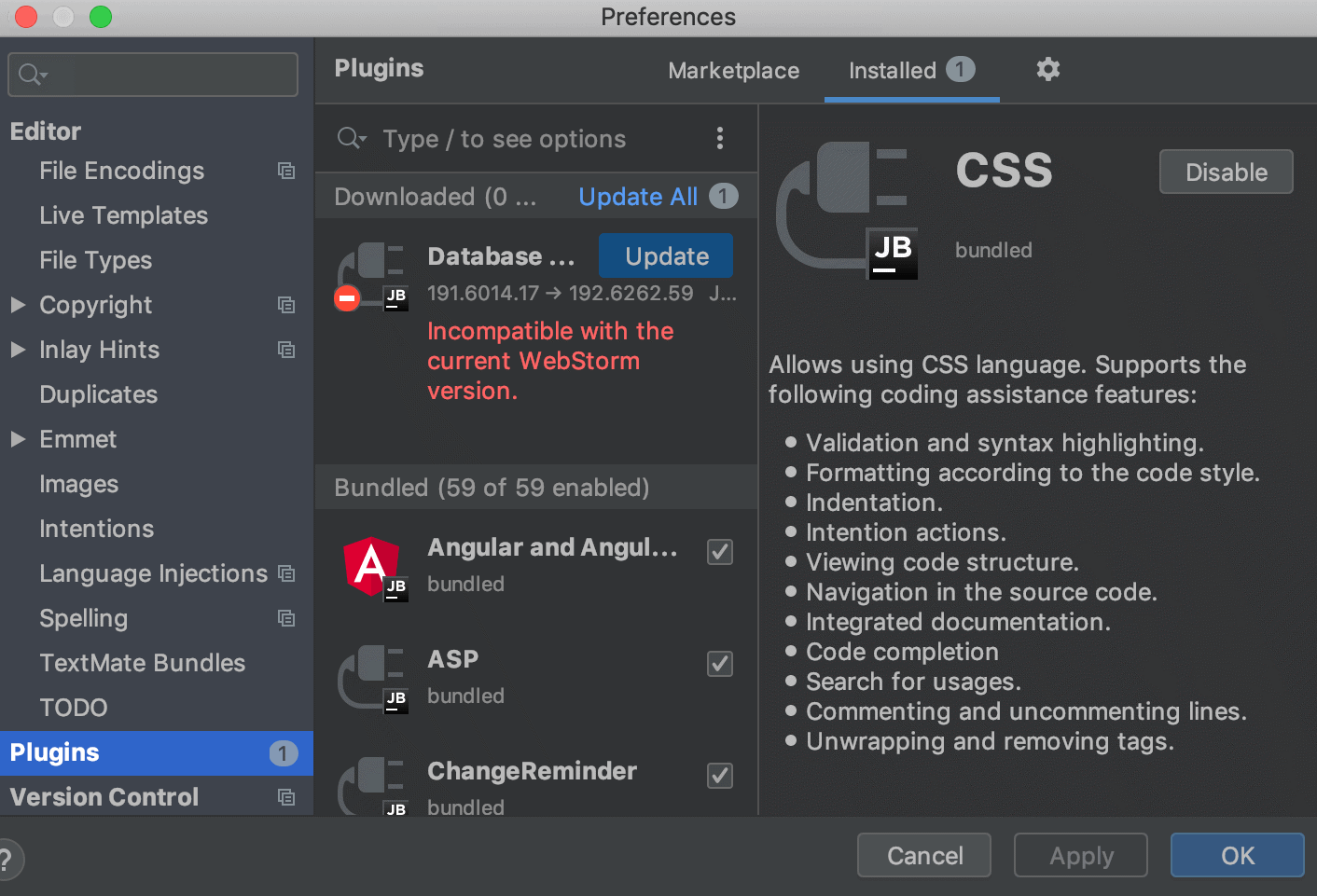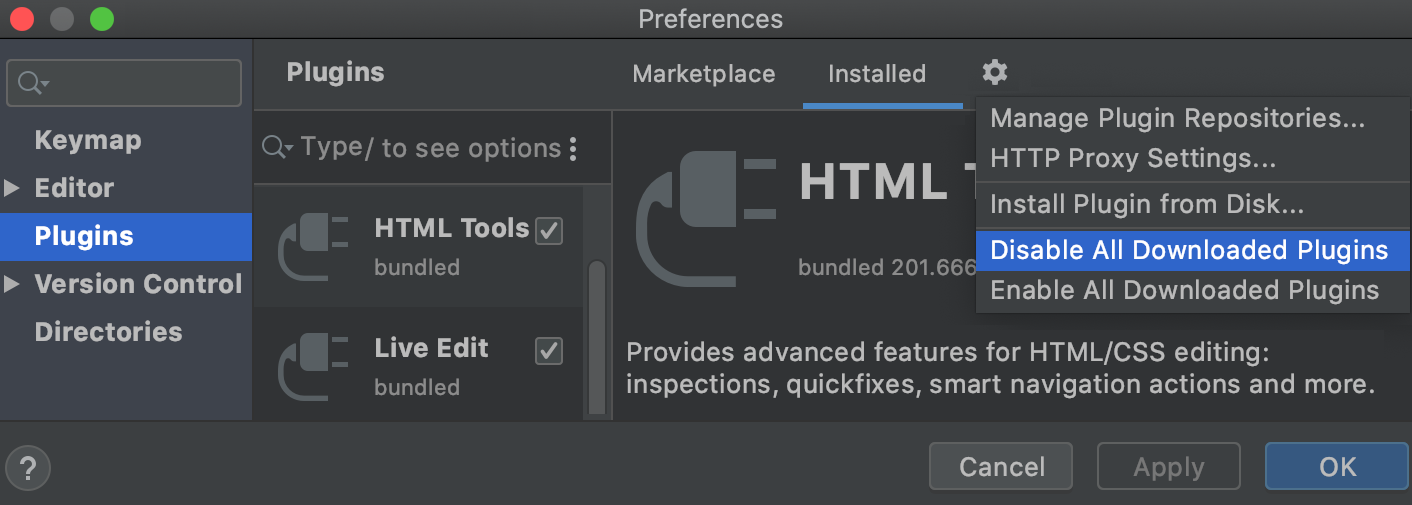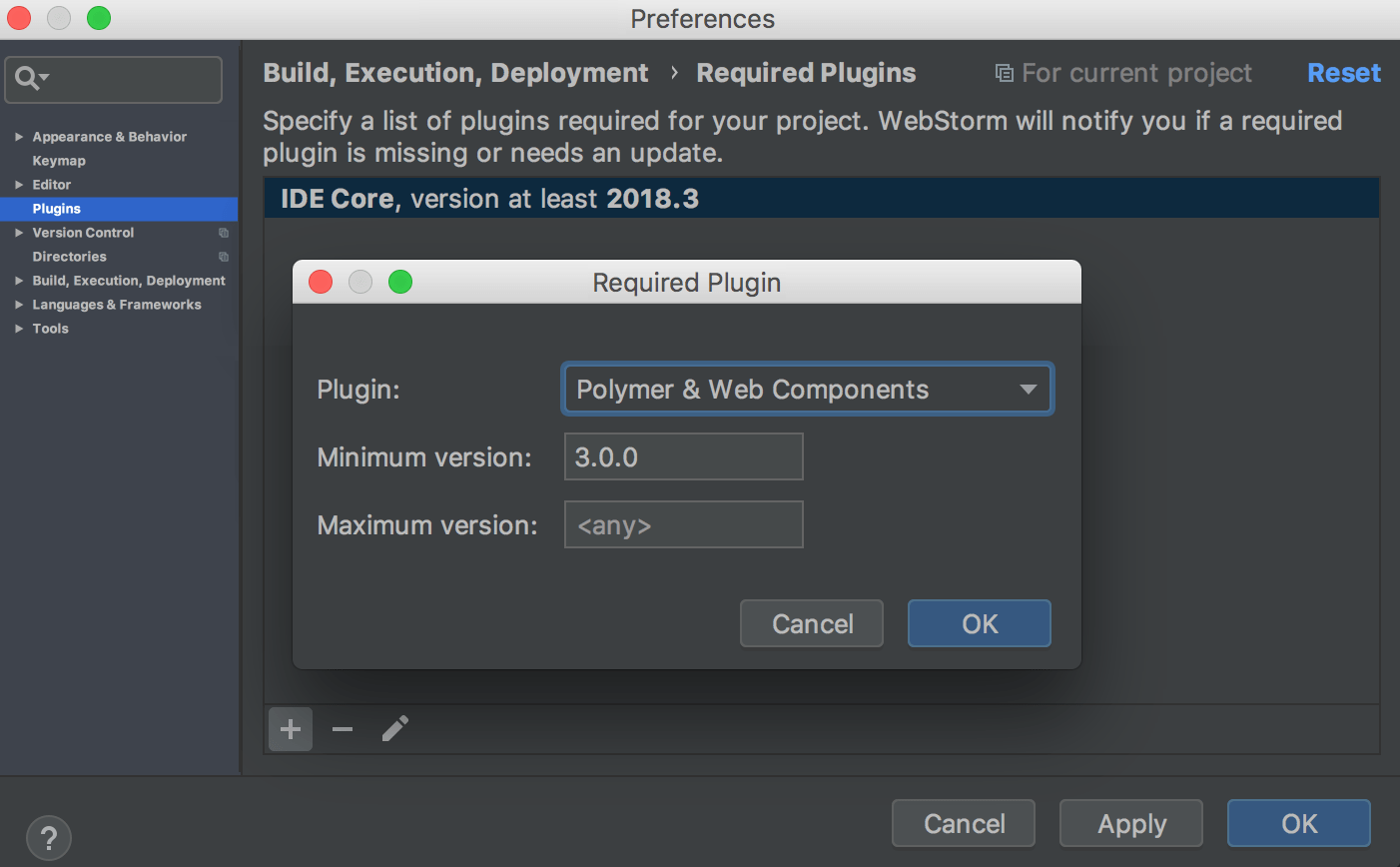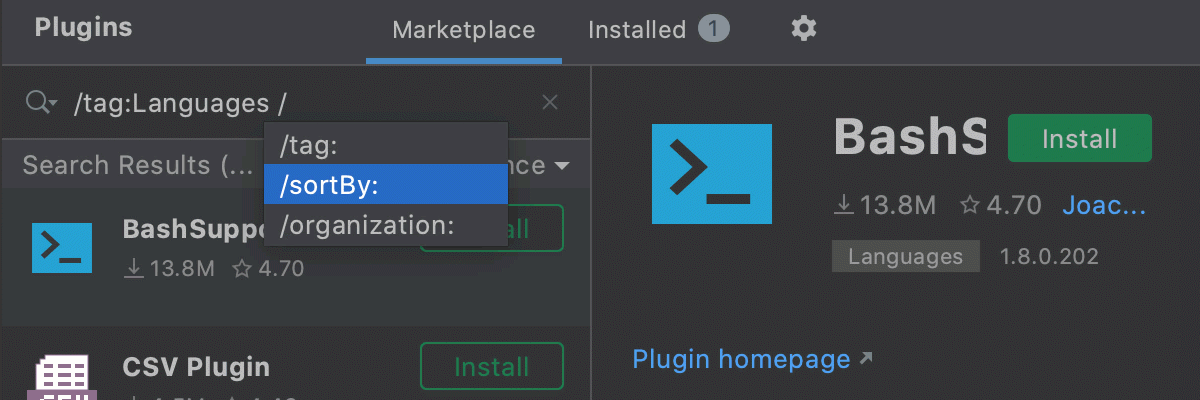Manage plugins
Plugins extend the core functionality of WebStorm. For example, by installing plugins, you can get the following features:
-
Integration with version control systems, Docker, Kubernetes, and other technologies
-
Coding assistance support for various languages and frameworks
-
Shortcut hints, live previews, File Watchers, and so on
-
Coding exercises that can help you to learn a new programming language
By default, WebStorm includes a number of bundled plugins. You can disable bundled plugins, but they cannot be removed. You can install additional plugins from the plugin repository or from a local archive file (ZIP or JAR).
Open plugin settings
- Press Ctrl+Alt+S to open IDE settings and select Plugins.

Use the Marketplace tab to browse and install plugins from the JetBrains Plugin Repository or from a custom plugin repository.
Use the Installed tab to browse bundled and installed plugins, enable, disable, update, or remove them. Disabling unnecessary plugins can increase performance.
If a plugin depends on some other plugin, WebStorm will notify you about the dependencies. If your project depends on certain plugins, add them to the list of required plugins.
Install plugin from repository
- Press Ctrl+Alt+S to open IDE settings and select Plugins.
-
Find the plugin in the Marketplace and click Install.
To install a specific version, go to the plugin page in the JetBrains Plugin Repository, download and install it as described in Install plugin from disk. For example, you can do it if the most recent version of the plugin is broken.
Install plugin from disk
-
Download the plugin archive (ZIP or JAR).
- Press Ctrl+Alt+S to open IDE settings and select Plugins.
-
On the Plugins page, click
and then click Install Plugin from Disk.
-
Select the plugin archive file and click OK.
-
Click OK to apply the changes and restart the IDE if prompted.
Remove plugin
- Press Ctrl+Alt+S to open IDE settings and select Plugins.
-
Open the Installed tab and find the plugin that you want to remove.
-
Click
on the plugin's description pane and select Uninstall.

Disable plugin
You can disable a plugin without removing it if you do not need the corresponding functionality.
- Press Ctrl+Alt+S to open IDE settings and select Plugins.
-
Open the Installed tab, find and select the plugin that you want to disable.
-
Click
on the plugin's description pane and select Disable for All Projects.
Alternatively, you can use the checkboxes in the list of plugins or the Disable All buttons for plugin categories.
You can disable or enable all manually installed plugins at once (non-bundled) in the menu under .

Custom plugin repositories
By default, WebStorm is configured to use plugins from the JetBrains Plugin Repository. This is a public repository where everyone can host their plugins. However, if you develop plugins for internal use only, you can set up a custom plugin repository for them.
For information about setting up a custom plugin repository, see the IntelliJ Platform SDK documentation.
Once you set up your plugin repository, add it to WebStorm:
- Press Ctrl+Alt+S to open IDE settings and select Plugins.
-
On the Plugins page, click
and select Manage Plugin Repositories.
-
In the Custom Plugin Repositories dialog, click
and specify your repository URL. It must point to the location of the updatePlugins.xml file. The file can be on the same server as your custom plugins, or on a dedicated one.

-
Click OK in the Custom Plugin Repositories dialog to save the list of plugin repositories.
-
Click OK in the Settings/Preferences dialog to apply the changes.
To browse the custom plugin repository, type repository: followed by the URL of the repository on the Marketplace tab of the Plugins page. For example:
Alternatively, you can replace the default JetBrains Plugin Repository with your custom repository URL. This can be helpful if you want only your custom repository plugins to be available from WebStorm. To do this, edit the platform properties or VM options file as described below. For more information, see Advanced configuration.
Use a custom plugin repository
-
From the main menu, select .
-
Add the
idea.plugins.hostproperty to the platform properties file . For example:idea.plugins.host="http://plugins.example.com:8080/"Make sure there is no plugins.jetbrains.com URL.
-
Restart WebStorm.
If you replace the default plugin repository with a custom one, the search field on the Marketplace tab of the Plugins dialog will browse only the plugins in your custom repository.
Required plugins
A project may require plugins that provide support for certain technologies or frameworks. You can add such plugins to the list of required plugins for the current project, so that WebStorm will verify that the plugins are installed and enabled. It will notify you if you forget about some plugin, or someone on your team is not aware about the dependency as they work on the project.
Add a required plugin for your current project
-
Make sure the required plugin is installed.
- Press Ctrl+Alt+S to open IDE settings and select Build, Execution, Deployment | Required Plugins.
-
On the Required Plugins page, click
and select the plugin. Optionally, specify the minimum and maximum version of the plugin.

When you open the project in WebStorm, it will notify you if the plugin is disabled, not installed, or requires an update.

Click the link in the notification message to quickly enable, install, or update the required plugin.
Productivity tips
Filter and sort search results
-
Type a forward slash
/in the search string to see options for filtering and sorting search results. For example, you can add the following options to your search string to list only language-related plugins and sort them alphabetically by name:/tag:Languages /sortBy:name
Or you can search for all outdated plugins among the installed by typing:
/outdated